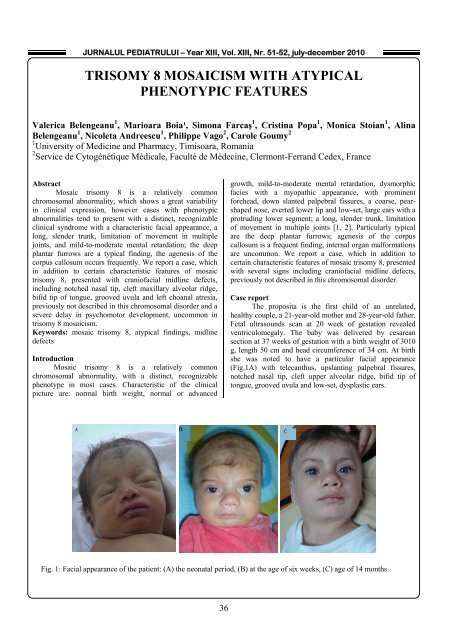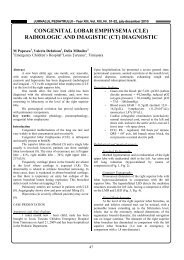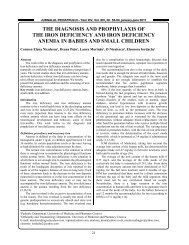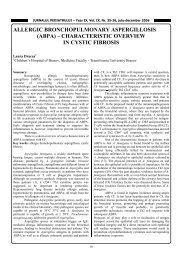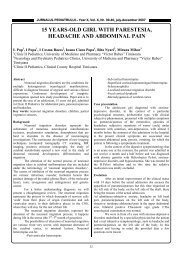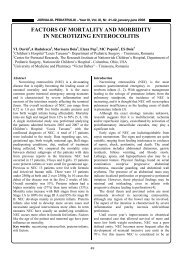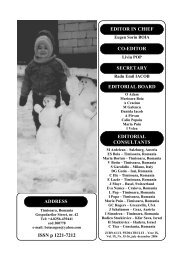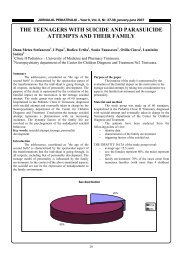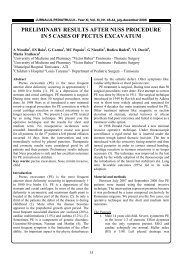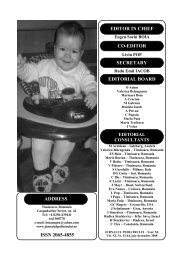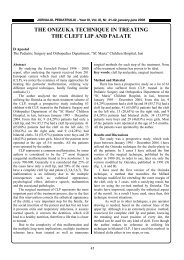TRISOMY 8 MOSAICISM WITH ATYPICAL PHENOTYPIC FEATURES
TRISOMY 8 MOSAICISM WITH ATYPICAL PHENOTYPIC FEATURES
TRISOMY 8 MOSAICISM WITH ATYPICAL PHENOTYPIC FEATURES
You also want an ePaper? Increase the reach of your titles
YUMPU automatically turns print PDFs into web optimized ePapers that Google loves.
JURNALUL PEDIATRULUI – Year XIII, Vol. XIII, Nr. 51-52, july-december 2010<br />
<strong>TRISOMY</strong> 8 <strong>MOSAICISM</strong> <strong>WITH</strong> <strong>ATYPICAL</strong><br />
<strong>PHENOTYPIC</strong> <strong>FEATURES</strong><br />
Valerica Belengeanu 1 , Marioara Boia¹, Simona Farcaş 1 , Cristina Popa 1 , Monica Stoian 1 , Alina<br />
Belengeanu 1 , Nicoleta Andreescu 1 , Philippe Vago 2 , Carole Goumy 2<br />
1 University of Medicine and Pharmacy, Timisoara, Romania<br />
2 Service de Cytogénétique Médicale, Faculté de Médecine, Clermont-Ferrand Cedex, France<br />
Abstract<br />
Mosaic trisomy 8 is a relatively common<br />
chromosomal abnormality, which shows a great variability<br />
in clinical expression, however cases with phenotypic<br />
abnormalities tend to present with a distinct, recognizable<br />
clinical syndrome with a characteristic facial appearance, a<br />
long, slender trunk, limitation of movement in multiple<br />
joints, and mild-to-moderate mental retardation; the deep<br />
plantar furrows are a typical finding, the agenesis of the<br />
corpus callosum occurs frequently. We report a case, which<br />
in addition to certain characteristic features of mosaic<br />
trisomy 8, presented with craniofacial midline defects,<br />
including notched nasal tip, cleft maxillary alveolar ridge,<br />
bifid tip of tongue, grooved uvula and left choanal atresia,<br />
previously not described in this chromosomal disorder and a<br />
severe delay in psychomotor development, uncommon in<br />
trisomy 8 mosaicism.<br />
Keywords: mosaic trisomy 8, atypical findings, midline<br />
defects<br />
Introduction<br />
Mosaic trisomy 8 is a relatively common<br />
chromosomal abnormality, with a distinct, recognizable<br />
phenotype in most cases. Characteristic of the clinical<br />
picture are: normal birth weight, normal or advanced<br />
growth, mild-to-moderate mental retardation, dysmorphic<br />
facies with a myopathic appearance, with prominent<br />
forehead, down slanted palpebral fissures, a coarse, pearshaped<br />
nose, everted lower lip and low-set, large ears with a<br />
protruding lower segment; a long, slender trunk, limitation<br />
of movement in multiple joints [1, 2]. Particularly typical<br />
are the deep plantar furrows; agenesis of the corpus<br />
callosum is a frequent finding, internal organ malformations<br />
are uncommon. We report a case, which in addition to<br />
certain characteristic features of mosaic trisomy 8, presented<br />
with several signs including craniofacial midline defects,<br />
previously not described in this chromosomal disorder.<br />
Case report<br />
The proposita is the first child of an unrelated,<br />
healthy couple, a 21-year-old mother and 28-year-old father.<br />
Fetal ultrasounds scan at 20 week of gestation revealed<br />
ventriculomegaly. The baby was delivered by cesarean<br />
section at 37 weeks of gestation with a birth weight of 3010<br />
g, length 50 cm and head circumference of 34 cm. At birth<br />
she was noted to have a particular facial appearance<br />
(Fig.1A) with telecanthus, upslanting palpebral fissures,<br />
notched nasal tip, cleft upper alveolar ridge, bifid tip of<br />
tongue, grooved uvula and low-set, dysplastic ears.<br />
Fig. 1: Facial appearance of the patient: (A) the neonatal period, (B) at the age of six weeks, (C) age of 14 months.<br />
36
JURNALUL PEDIATRULUI – Year XIII, Vol. XIII, Nr. 51-52, july-december 2010<br />
On both hands deep palmar creases were observed<br />
(Fig. 2 A), a single transverse palmar crease and a single<br />
flexion crease on the fifth fingers; the thumbs were<br />
proximally inserted bilaterally (Fig. 2 B). The feet were in<br />
equinovarus position, with a wide space between the first<br />
and second toes and deep plantar grooves bilaterally. The<br />
perinatal period was complicated with seizures and apneic<br />
episodes.<br />
Fig. 2 (A) Bifid tip of tongue and grooved uvula, deep palmar creases, single flexion crease on<br />
the fifth finger. (B) Foot image - “hallmark “ sign of the syndrome.<br />
Transfontanellar ultrasound revealed absence of<br />
corpus callosum and enlargement of the occipital horns of<br />
lateral ventricles. MRI imaging confirmed the agenesis of<br />
corpus callosum and mild enlargement of lateral ventricles,<br />
on the other hand excluded associated cerebral<br />
malformations (Fig. 3 A, B). Cardiac ultrasonography<br />
showed an atrial septal defect. On oto-rhino-laryngologic<br />
examination left choanal atresia was found.<br />
Fig. 3 (A) Mild enlargement of lateral ventricles (B) Agenesis of corpus callosum.<br />
On clinical examination at six weeks of age, she had<br />
telecanthus, broad nasal bridge, bulbous nasal tip with a<br />
small pit in the midline and micrognathia (Fig. 1B). A small<br />
midline cleft of the maxillary alveolar ridge, a bifid tip of<br />
tongue and grooved uvula were noted. The ears were lowset,<br />
abnormally shaped with thickened cartilage. She had<br />
soft dark hair on the forehead extending to the eyebrows.<br />
The neck was short with redundant skin folds and the chest<br />
was narrow with widely spaced nipples.<br />
The deep palmar and plantar creases in association<br />
with corpus callosum agenesis were highly suggestive of<br />
trisomy 8. Chromosome analysis on peripheral blood<br />
lymphocyte culture revealed trisomy 8 (Fig. 4) in 12<br />
metaphases of a total of 50 examined metaphases. FISH<br />
analysis on cultured blood lymphocytes with a centromeric<br />
probe of chromosome 8 (CEP8-Spectrum Orange, Abbott-<br />
Vysis) showed 3 hybridization signals in 25 % of cells (120/<br />
492 nuclei) (Fig. 5).<br />
37
JURNALUL PEDIATRULUI – Year XIII, Vol. XIII, Nr. 51-52, july-december 2010<br />
Fig. 4: Metaphase showing three copies of chromosome 8.<br />
In view of the patient’s facial appearance not typical<br />
of mosaic trisomy 8 and especially the midline defects<br />
previously not reported in trisomy 8 mosaicism, an array-<br />
CGH was performed to investigate the possibility of cryptic<br />
unbalanced rearrangements. The commercially available<br />
array (GenoSensor Array 300, Abbott) contains 287<br />
genomic targets that include telomere, microdeletion,<br />
oncogenes, tumor suppressor genes and other selected loci<br />
scattered along each chromosome arm. No genomic<br />
imbalance could be detected.<br />
We reassessed the patient at the age of 14 months:<br />
length was 84 cm (> 95 %), head circumference was 46 cm<br />
(50 %); she had a slender body habitus, broad face (Fig.<br />
1C), short webbed neck and funnel-shaped chest. Except for<br />
mild limitation of movement in the right ankle, no<br />
restriction of movement at any joints could be detected.<br />
Developmental milestones were grossly delayed: she can sit<br />
alone briefly, cannot stand or crawl, she started to babble<br />
recently, using single syllables, does not recognize her name<br />
or respond to simple commands.<br />
Discussions<br />
Trisomy 8 mosaicism is characterized by a great<br />
variability in clinical expression due to the variation in<br />
tissular repartition of normal and trisomic clones [3, 4],<br />
therefore reported patients show a highly variable<br />
combination of clinical findings. Mental retardation is<br />
variable from mild-to-severe, but individuals with normal<br />
intellect and even with entirely normal phenotype have been<br />
described. However, cases with phenotypic abnormalities<br />
tend to present with a distinct clinical picture. Our case has<br />
many of the characteristic features of mosaic trisomy 8,<br />
including the long and slender body habitus, the deep<br />
plantar creases and the agenesis of corpus callosum.<br />
Fig. 5: Interphase FISH with a centromeric<br />
probe for chromosome 8 (CEP 8-Spectrum Orange)<br />
1/4 of nuclei with three hybridization signals.<br />
However, the facial appearance is not typical of trisomy 8<br />
mosaicism, and the midline clefts and choanal atresia have<br />
not been described to date in patients with mosaic trisomy 8.<br />
Corpus callosum agenesis generally prolonged<br />
latencies of interhemispheric stimulus-response paradigms,<br />
but not with unilateral stimulation paradigms to be<br />
processed. Peru et al. [5] found in patients with traumatic<br />
lesion of the corpus callosum, both temporary and<br />
permanent impairment such as dyspraxia, dyslexia and<br />
dysnomie firmly. Lassonde et al. [6] thought that different<br />
morphological and functional pathology of the corpus<br />
callosum, regularly lead to impairment in tasks that the<br />
integration visual and tactile information crosses the midline<br />
or the transfer of motor or visual-spatial skills required.<br />
Sauerwein et al. [7] discussed that the cognitive functions<br />
are not generally impaired in the absence of the corpus<br />
callosum, but it may appear a greater variability of these<br />
functions. For the clinicians is particularly important that the<br />
mosaic trisomy 8, may be associated with language<br />
impairment, respectively cognitive deficits. If language<br />
impairment is found cytogenetic investigation may be<br />
initiated. This is especially true when a combination with<br />
congenital malformations (kidney, skin, brain, heart,<br />
vertebrae among others) is present.<br />
The diagnosis of mosaic trisomy 8 is not only for the<br />
assessment of development, but also has other significant<br />
consequences. Trisomy 8 is a frequently acquired<br />
cytogenetic abnormality in myeloid disorders. In patients<br />
with myeloid disorders the abnormal cells appeared to have<br />
developed from the trisomic clones. Patients with mosaic<br />
trisomy 8 may be at increased risk for the development of<br />
CML and MDS [8, 9, 10].<br />
The additional anomalies might be part of the more<br />
severe manifestations within the phenotypic spectrum of<br />
38
JURNALUL PEDIATRULUI – Year XIII, Vol. XIII, Nr. 51-52, july-december 2010<br />
mosaic trisomy 8, due to a high proportion of trisomic cells<br />
in the developing facial structures. The array-CGH did not<br />
reveal further imbalances, however the array used is not<br />
pangenomic, and small gains or losses of genetic material<br />
may have escaped detection [11]. Trisomy 8 mosaicism,<br />
unlike the other common trisomies, in the majority of cases<br />
results from postzygotic mitotic nondisjunction [12, 13, 14],<br />
nevertheless, a proportion of cases are due to meiotic<br />
nondisjunction. Inasmuch as we could not investigate the<br />
parental origin of the three copies of chromosome 8, it<br />
cannot be excluded that uniparental disomy of chromosome<br />
8 in the euploid cell lines might be responsible for the<br />
atypical phenotypic features, through either homozigosity<br />
for a mutation in a gene located on chromosome 8 or<br />
abnormal genomic imprinting. However, the latter seems<br />
improbable, since individuals reported with both maternal<br />
and paternal uniparental disomy of chromosome 8 had an<br />
entirely normal phenotype [15].<br />
Conclusions<br />
We described a case with mosaic trisomy 8, which in<br />
addition to certain characteristic features of this syndrome<br />
presented with craniofacial midline defects, previously not<br />
described in this chromosomal disorder. We consider the<br />
clinical findings in our patient may contribute to the<br />
extension of the phenotypic spectrum of trisomy 8<br />
syndrome.<br />
References<br />
1. Schinzel A. Catalogue of unbalanced chromosome<br />
aberrations in man, 2 nd ed., Walter de Gruyter, Berlin<br />
2001, pp. 325-328;<br />
2. Kurtyka ZE, Krzykwa B, Piytkowska E, et al. Trisomy 8<br />
mosaicism syndrome: two cases demonstrating<br />
variability in phenotypes. Clin Pediatr 1988; 27:557-564;<br />
3. Jordan MA, Marques I, Rosendorff J, et al. Trisomy 8<br />
mosaicism: a further five cases illustrating marked<br />
clinical and cytogenetic variability. Genet Couns 1998;<br />
9:139-146;<br />
4. Miller K, Arslan-Kirchner A, Schulze B, et al.<br />
Mosaicism in trisomy 8: phenotype differences<br />
according to tissular repartition of normal and trisomic<br />
clones. Ann Genet. 1997; 40:181-184;<br />
5. Peru A, Beltramello A, Moro V et al. Temporary and<br />
permanent signs of interhemispheric disconnection after<br />
traumatic brain injury. Neuropsychologia 2003; 41: 634–<br />
643;<br />
6. Lassonde M, Sauerwein C Neuropsychological outcome<br />
of corpus callosotomy in children and adolescents. J<br />
Neurosurg Sci 1997; 41: 67–73;<br />
7. Sauerwein HC, Lassonde M. Cognitive and sensorimotor<br />
functioning in the absence of the corpus callosum:<br />
neuropsychological studies in callosal agenesis and<br />
callosotomized patients. Behav Brain Res 1994; 64:<br />
229–240;<br />
8. Brady AF, Waters CS, Pocha MJ, Brueton LA Chronic<br />
myelomonocytic leukaemia in a child with constitutional<br />
partial trisomy 8 mosaicism. Clin Genet 2000; 58: 142–<br />
146;<br />
9. Maserati E, Aprili F, Vinante F et al. Trisomy 8 in<br />
myelodysplasia and acute leukemia is constitutional in<br />
15–20% of cases. Genes Chromosomes Cancer 2002; 33:<br />
93–97;<br />
10. Maserati E, Pressato B, Valli R et al. Constitutional<br />
trisomy 8 mosaicism in primary myelofibrosis: relevance<br />
to clinical practice and warning for trisomy 8 studies.<br />
Cancer Genet Cytogenet 2007; 179: 79–81;<br />
11. Isabel Filges , Benno Röthlisberger , Friedel Wenzel,<br />
Karl Heinimann, Andreas R. Huber , Peter Miny. Mosaic<br />
ring chromosome 8: Clinical and array-CGH findings in<br />
partial trisomy 8. Am J Med Genet A. 2008 1; 146 A<br />
(21):2837-41;<br />
12. Said Baidas, T-J. Chen, Valentin Kolev, Lee-Jun Wong,<br />
Joel Imholte, Naigeng Qin, Jeanne Meck. Constitutional<br />
Trisomy 8 Mosaicism Due to Meiosis II Non-<br />
Disjunction in a Phenotypically Normal Woman With<br />
Hematologic Abnormalities. Am J Med Genet 2004;<br />
124A:383–387;<br />
13. Weaver BA, Silk AD, Cleveland DW.Cell biology:<br />
nondisjunction, aneuploidy and tetraploidy. Nature.<br />
2006; 17;442 (7104):E9-10;<br />
14. Baidas S, Chen TJ, Kolev V, et al. Constitutional<br />
trisomy 8 mosaicism due to meiosis II non-disjunction in<br />
a phenotypically normal woman with hematologic<br />
abnormalities. Am J Med Genet 2004; 124:383-387;<br />
15. Kotzot D and Utermann G. Uniparental disomy (UPD)<br />
other than 15: phenotypes and bibliography updated. Am<br />
J Med Genet A. 2005; 30; 136(3):287-305.<br />
Correspondence to:<br />
Valerica Belengeanu,<br />
University of Medicine and Pharmacy<br />
Department of Medical Genetics,<br />
P-ta Eftimie Murgu No. 2,<br />
Timisoara, Romania<br />
E-mail: belvtim@yahoo.com<br />
39


